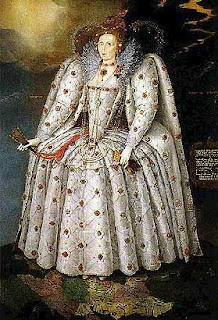Staging in the Elizabethan Drama
domingo, 19 de junio de 2011
MUSIC, DANCE AND SPECIAL EFFECTS IN THE ELIZABETHAN DRAMA
Music was an extra effect added in the 1600's through a French influence. The musicians would also reside in the Lords rooms. Elizabethan music was heard in churches, in the streets, in the courts, and in theaters and has a specific rhythm that reminds Baroque music. Anthems, madrigals, and operas were popular musical forms of the period. Two English composers of the Elizabethan Age were William Byrd, John Dowland and Thomas Tallis. William Shakespeare's plays are full of songs and references to music. Theater musicians played either on stage, above the stage, or even under the stage. In the Elizabethan era, most actors had to be able to sing and dance to be able to perform any role in a play. Not being able to sing or dance could damage their chances of being successful.
Instruments
Several musical instruments were invented during this time, and belonged to four kinds of musical kinds (string, keyboard, wind and percussion): The hautboy, an early version of the oboe (used in Shakespeare’s Macbeth); an early violin, called a viol, and a keyboard known as the spinet or harpsichord. The Chittarone is a lute which could reach 6 feet tall. It had an elongated neck to which long bass strings were attached to an additional peg-box. But the most popular instrument played in the Elizabethan era was the lute, a musical instrument from the Medieval era, which is a kind of guitar. The different instruments were used to represent the status of each person. If the scene was happy, a fast beat type of song was played while if the scene indicated sorrow or sadness, the music was much slower.
Hautboy:
YANAGITA tokinori – woodwind maker.Baroque and early classical flute traverse and oboe (hautboy) maker.
Viol:
miércoles, 15 de junio de 2011
COSTUMES IN THE ELIZABETHAN THEATRE
People in the Elizabethan era were not allowed to wear whatever they like. There were a several laws called Sumptuary Laws. The penalties for violating Sumptuary Laws could be harsh. Also the clause applied to actors and their costumes. Acting Troupes had to be licensed; the licenses were granted by the Queen to the aristocracy for the maintenance of troupes of players.
The Elizabethan theatre costumes were colourful, vibrant and eye catching. Almost everything colors of clothing had its own meaning and conveyed an enormous amount of information during the Elizabethan era and this meaning was totally understood by the audience. The types of materials and fabrics had a great effect too.
During the Elizabethan era only men were allowed to act in the theatre until 1660, then there weren´t actresses so the men had to represent the female roles. They had to use wigs or periwigs.
The Elizabethan Women's clothing was very elaborate and was constructed with many layers of clothing. A woman’s costume consisted of a singlet or chemise, corset, generally made of whalebone to pinch the waist so as to give an appearance of an incredible petite frame; stocking, pantalets, and under skirt, a stomacher, which was a filler for the deep neck of a dress. Materials like taffeta and brocade was also widely used. The dresses were full skirted and sleeved. The sleeves were worn apart and the ensemble accessorized with shoes, capes, hats and reticules.
The men’s costume at the Elizabethan theatre was a shirt, stockings, britches, doublet which was a well fitted coat, sleeves separate, same stiff high collar and an overcoat. Also a cape and hat. Cravats were also an integral part of the men’s attire.
Many of the plays had historical themes featuring the royalty and nobles of the land, for example Elizabethan Nobles and Upper classes wore clothing made of velvets, furs, silks, lace, cottons and taffeta.
The night scenes were often signalled by characters wearing nightdresses.
Images of Costumes in the Elizabethan Theatre
Suscribirse a:
Entradas (Atom)



